What area is heated by one section of a bimetallic radiator. How to calculate the number of sections of bimetallic radiators for home heating
The market for heating equipment today provides an extensive range of a wide variety of radiators, including cast iron, aluminum, bimetallic and stamped radiators made of steel.
Click image for larger version
Required heating power
When we are faced with the choice of which radiators to choose, then, willy-nilly, we have to study their features, i.e. pros and cons of different designs. Choose usually from four main positions:
- Pig-iron radiators, as you know, give off not bad heat, they are operated for a long time (up to 35 years, and sometimes even more); do not corrode; They withstand the increased pressure in the system, but are heavy and not particularly aesthetic.
- Aluminum radiators attract a very high heat dissipation, as well as lightweight and elegant appearance, but are expensive and not very good in terms of resistance to high pressure in the heating system.
- Bimetallic radiators, gathered in their design the advantages of those and others, are made of steel pipes for heat carrier, capable of withstanding high pressures if necessary, having an aluminum body, which gives off heat perfectly.
- Steel radiators, made of high-quality cold-rolled steel, due to which they have a sufficiently high heat transfer and strength, consist of several flat panels for the coolant.
For optimal heating of the room, you need to know the answer to the question not only about which radiators to choose, but also to make the right calculation.
We must not forget that over time, the heat-release properties of radiators gradually decrease. Installing more powerful radiators, we reduce the load on the boiler or boiler. Because most often, making the calculation bimetallic radiators, acquire radiators with the number of sections one or two more than the number of previous cast iron batteriesif any have been installed.

If you want to make the calculation of bimetallic radiators for the room, you must proceed from the heat-release properties of each of the sections
If you need to make an approximate calculation of bimetallic radiators for a new room or house, we proceed from the heat-transfer characteristics of each section. This parameter must be specified in the technical data sheet for radiators. In practice, the same practice often takes the same 100 watts per section and 50-100 watts per square meter, so that a certain reserve is obtained, i.e. the number of sections equal to the actual number of square meters of each area.
Which is better: a warm and large radiator or hot, but small?
- If we install batteries of small size, then we will have to increase the heat transfer by increasing the temperature of the coolant. This option is called - high-temperature heating.
- It is possible to install large-sized radiators taking into account a certain heat transfer. This implies a lower temperature on their surface. This option is called low-temperature heating. Obviously, it attracts more security, and you can save.
If we choose high-temperature heating, the radiators in the house will be so hot that it will be almost impossible to touch them. This option is bad because, due to overheating of water, it is dangerous, but it is also not economical - there is no reserve for regulation. In addition, at high temperatures, the surrounding dust precipitated by batteries may begin to decompose, which does not contribute to the improvement of ambient air.
Hence, we conclude that high-temperature type of heating for residential premises is not very suitable.
Selection and calculation of the radiator

In practice, as a rule, they take 100 watts per section, and 50-100 watts per 1 square meter. meter, so that the calculation of bimetallic heating batteries was calculated with some margin
So, we chose the low-temperature variant of home heating as the most optimal one. In this case, our radiators heat up, give off heat to the space, but they are warm, not super hot. And here it is necessary to calculate the correct area of radiators, so that it is safe and comfortable.
In order to roughly calculate the number of radiators we need for heating a specific area of a room, whether it be a hall, kitchen or bedroom, as well as the whole house, we must first determine the volume of a room. For this, the length of the room is multiplied by its width and height.
The required amount of thermal energy for optimal heating of the room depends on its type. If you take a standard room in a panel house, then for 1 cu. m is required by the average standard 0.041 kW.
The level of heating depends on the effectiveness of the insulation of a particular room. That is, from what the house is made of, what is the thermal insulation, whether plastic windows and heated doors are installed in it. Depending on this, the level of thermal energy per 1 cu. m. may decrease to 0.034 kW. If we are talking about new houses built according to modern technologies of thermal insulation and taking into account the latest building standards, it is possible to reduce the required thermal power per 1 cubic meter almost doubled - up to 0.02 kW.
After completing the preliminary calculations of radiators, choose the brand and type of batteries. Each radiator has its own characteristics. And one of the most important is the nominal heat flow. This unit is denoted by the symbols Qn., [KW]. Usually this characteristic is indicated in the catalog for a separate section of the radiator (sometimes for several).
In the absence of this information in the catalogs, check it with the sellers. Just sort out the parameters of your room and choose the type of radiator that suits you, proceed to the calculation of the number of sections required for your home.
Calculation of the number of sections

Accurate calculation of bimetallic radiators is considered rather complicated. Known formulas for calculations should contain many variables. It is mandatory to take into account the height of the ceiling and the insulating qualities of plastic or wooden windows. After all, it is no secret that only through windows up to 70% of heat can go away!
The number of sections is indicated by the symbol S (pieces). This is the parameter we need. It is determined by the formula:
S = (V Q pom) / Q number [pieces],
where V - denotes the volume of a given room;
Q pom - the amount of heat energy, depending on the specific parameters of the room;
Q nom is the rated heat flux of the battery.
The result you get is round to integer values (upward). So, if the value of S = 9.3 is released, round it exactly to 10.0.
It remains now to resolve the issue with the number of radiators in the room. Do you need a device from one 10-cell battery or will it be better to supply one or two 5-cell ones?
It depends on the area of the room. The room is more than 25 square meters. with optimal use of multiple radiators. The fact is that it is more favorable for air circulation. In addition, space heating will be more uniform.
If you chose a steel stamped radiator, then you need to take into account its dimensions and, of course, the nominal heat flux (figures must be specified in the catalog).
It should be understood that the method of calculating radiators given by us is rather simplified. It uses averaged numbers and coefficients. Such calculations are used in standard situations when radiators are installed in a standard apartment or an individual house with central heating, where a number of conditions are observed. Among them is the ceiling height (not more than 3 m); and the temperature (coolant) in the system should not be more than 70 degrees. WITH.
Possible errors and nuances
If the ceiling height is above 3 m, the heat output should be increased proportionally to the increase in this parameter. If the ceiling of the room, on the contrary, is smaller, the value of the required heat output will decrease.
If the house has plastic windows with a rather low heat loss, the heat output can be reduced in the range of 10-20%.
If the coolant temperature is far from 70 degrees. C, the output power changes accordingly by 15-18% for every 10 degrees of lowering / raising the temperature.
So, if the temperature of the liquid in the batteries (coolant) is about 50 degrees. C, the power must be increased by 1, 5 times.
If there are two windows in a room, it would be better to install a couple of sections - one under each window - as for the total heat output, it should be 1.7 times higher than the nominal one.
What to look for
If you need a more accurate calculation, it makes sense to look for information to the specialized literature, where radiators are considered more detailed and deeper. For more accurate calculations, it will be necessary to take into account such values as the temperature inside and outside; composition and temperature of the coolant; probable heat loss; thermal conductivity of different materials and many other parameters.
If your time is dear to you, the best way out will be to make the calculation of heating radiators to qualified heating technicians. Then you will not only accurately calculate the number of required radiator sections for a room or house, but also establish the radiator that is most suitable for living space.

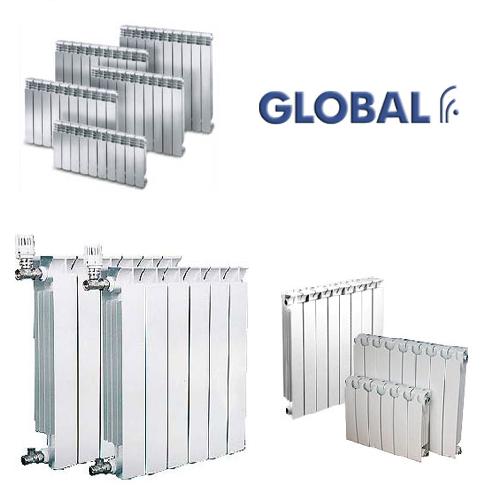
Warmly indoors especially in winter is necessary. And this problem is solved, including bimetallic radiators of heating.
Today the market is saturated with heating equipment, and radiators act on it as leaders. Among the huge number of iron, steel and aluminum batteries, a niche was found and rightly occupied by bimetallic radiators.
It is fully justified. They have a large margin of safety, provide full heating. Their working pressure reaches 30 atmospheres, and this is not the limit. In addition, they have an attractive appearance.
They have combined the main advantages aluminum radiators and strength characteristics of steel.
Bimetallic radiator is heating devicehaving a body made of aluminum and a steel pipe with a coolant moving along it.
How to perform the calculations?
There are ways to determine how many sections on a bimetal heating radiator should be to have enough heat.
In one of them, the calculation of the number of radiators is carried out by area of the room.
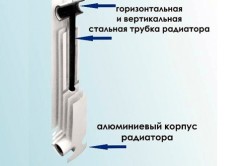
The area (S) is multiplied by the heating power of 1 m² of the room (P room) and is divided by the power of 1 section of the radiator (P number). The result, rounded to the nearest whole number, is the required number.
Each manufacturer uses its own heat transfer performance. In our case, the value of P pom. will correspond to 50-100 watts. The figure is taken from practice, averaged.
This method allows you to do the calculation in standard rooms with one window, door, exterior wall and ceiling with a maximum height of 3 m.
If the room is angular or face, the coefficients with sizes 1.1-1.3 are applied.
Another method uses volumetric indicators..
- The volume of the room is calculated (height, width and length are multiplied).
- The brand and type of bimetallic radiator is determined.
- The formula calculates the required number
N = V x Q pom. / Q no.,
where N is the number of sections in pieces,
Q number - heat flow 1 radiator section, nominal,
Q pom. - thermal energy required for heating 1m³
standard room
V is the volume of the heated room.
Q pom. - the indicator has different values and depends on the type of room. In practice, for convenience, operate with values from 39 to 41 watts.
Q number - the information is contained in the technical passport of the product, and only the power of section 1 is indicated.
The result is rounded up to a whole number.
This calculation is simplified. It uses averages. It is applicable to standard rooms with central heating and certain conditions, such as coolant temperature not exceeding 70 ° C, ceiling with a height of 3 m.
What you need to know when calculating?
- The power range of standard bimetallic sections is about 120-220 watts.
- It is necessary to take into account accidents, for which the heat reserves should be increased by 25%. Ways do not matter: either by the number of sections, or by their power.
- To adjust the temperature in the rooms on the bimetallic radiators should install special tools (additional taps).
- When the floor space is from 25 m² and above, instead of 1 long heating radiator, it is advisable to install several radiators with a smaller number of sections.
This will improve air circulation, provide a more uniform flow of heat into the room, reduce the likelihood of leakage.
- High-quality insulation will make the calculation more accurate.
- An increase or decrease in the height of the ceiling leads to a change in the required amount of thermal energy in appropriate proportions.
- Plastic windows up to 20% reduce heat output.
- Fluctuations in the temperature of the coolant from the base 70 ° С change the output power in the ratio of 18% to 10 ° С.
- If there are several windows, it is advisable to place each section of the radiator under the window. The total heat energy of bimetallic radiators must be 1.5 times larger than the nominal.
To accurately calculate the number of bimetal radiator sections, a huge number of variables are required. Here and the height of the ceilings, the presence of windows, the type of glass, temperature inside and outside the room, the coolant, the number of external walls, their insulating properties, thermal conductivity of materials and much more.
It is difficult, but possible. It takes only special literature or professional services.
It's time to change the batteries.
From the calculations of the number of nodes depends on comfort in the cold season.
How to make all the calculations, measurements?
It's quite simple, if you follow the instructions below.
Before you buy a battery of heating consider the ways to calculate the number of their elements.
The first method is based on the area of the room. Construction standards (SNiP) states that for normal heating 1 square. m. requires 100 watts. thermal power. Measuring the length, width of the room, and multiplying these two values, we obtain the area of the room (S).
To calculate the total power (Q), substitute in the formula, Q = S * 100 W., our value. In the passport to the radiators of heating indicated the heat transfer of one element (q1). With this information, we learn the necessary number of them. To do this, divide Q by q1.

The second method is more accurate. It should also be used with a ceiling height of 3 meters. Its difference lies in measuring the volume of the room. The area of the room is already known, measure the height of the ceiling, then multiply these values. The resulting value of the volume (V) is substituted to the formula Q = V * 41 W.
According to building codes 1 cu. m. should be heated 41 watts. thermal power. Now we find the ratio of Q to q1, getting the total number of nodes of the radiator.
Let's summarize the intermediate result data that will be needed for all types of calculations.
- Wall length;
- Wall width;
- Ceiling height;
- Power standards, heating a unit of area or volume of a room. They are given above;
- Minimum heat emission radiator element. It must be indicated on the passport;
- Wall thickness;
- The number of window openings.
A quick way to calculate the number of sections
 When it comes to replacing cast iron radiators bimetallic, you can do without scrupulous calculations. Taking into account several factors:
When it comes to replacing cast iron radiators bimetallic, you can do without scrupulous calculations. Taking into account several factors:
- Bimetallic section gives a ten percent increase in heat output compared to cast iron.
- Over time, battery performance drops.. This is due to the deposits that cover the walls inside the radiator.
- Better to be warmer.
The number of elements of a bimetallic battery should be the same as that of its predecessor. However, this number is increased by 1 - 2 pieces. This is done to combat the future decrease in the efficiency of the heater.
For standard room
We already know this method of calculation. It is described at the beginning of the article. Let us examine it in detail, referring to a specific example. Calculate the number of sections for a room of 40 square meters. m
According to the rules of 1 square. m requires 100 watts. Suppose that the power of one section is 200 watts. Using the formula, from the first section we find the required thermal capacity of the room. Multiply 40 square meters. meters per 100 watts, we get 4 kW.
To determine the number of sections, we divide this number by 200 watts. It turns out that for placing a given area will require 20 sections. The main thing to remember is that the formula is relevant for apartments where the ceiling height is less than 2.7 m.
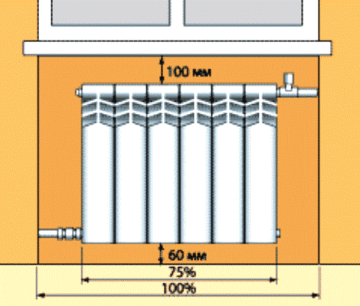
For non-standard
Non-standard rooms include corner, front rooms, with several window openings. This category also includes dwellings with a ceiling height of more than 2.7 meters.
For the former, the calculation is carried out according to the standard formula, but the final result is multiplied by a special coefficient, 1 - 1.3. Using the data obtained above: 20 sections, suppose that the room is angular and has 2 windows.
The end result is obtained by multiplying 20 by 1.2. This room requires 24 sections.
If we take the same room, but with a ceiling height of 3 meters, the results will change again. Let's start with the calculation of the volume, multiply 40 square meters. m. to 3 meters. Remembering that on 1 cu. m requires 41 watts., calculate the total heat output. Received 120 cu. m multiply by 41 W.
The number of radiators will be obtained by dividing 4920 by 200 watts. But a corner room with two windows, therefore, 25 should be multiplied by 1.2. The final total of 30 sections.
Exact calculations with many parameters
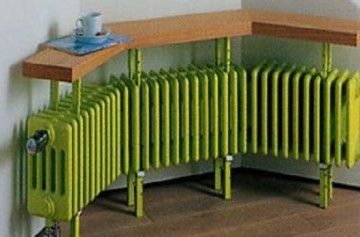 To make such calculations is difficult. The above formulas are valid for the normal premises of central Russia. The geographical location of the house and a number of other factors will introduce additional correction factors.
To make such calculations is difficult. The above formulas are valid for the normal premises of central Russia. The geographical location of the house and a number of other factors will introduce additional correction factors.
- The final formula for the corner room, should have an additional factor of 1.3.
- If the house is located not in the middle zone of the country, the additional factor is described by the building regulations of this territory.
- Consider the installation location of the bimetallic radiator. and decorative items. For example, the niche under the window will take 7%, and the screen up to 25% of the thermal capacity of the battery.
- What will the room be used for?
- Wall material and thickness.
- What are the frames and glass.
- Door and window openings introduce additional problems. Let us dwell on them in more detail.

Walls with windows, street and with doorways, change the standard formula. It is necessary to multiply the obtained number of sections by the heat transfer coefficient of the room, but it must first be calculated.
This figure will consist of the heat transfer of the window, doorway and wall. All this information can be obtained by referring to the SNiP, according to its type of premises.
Electric oil radiators, working principle and how to choose on
Useful tips for proper arrangement of the heating system
Bimetallic radiators come from the factory connected in 10 sections. After calculations, we got 10, but we decided to build another 2 in reserve. So, it is better not to do it. Factory assembly is much more reliable, it is given a warranty from 5 to 20 years.
The assembly of 12 sections will be made by the store, while the guarantee will be less than a year. If the radiator starts to flow, soon after the end of this period, repairs will have to be carried out on its own. The result - extra problems.
Let's talk about the effective power of the radiator. Specifications bimetallic sectionindicated in the passport of the productIt is assumed that the temperature of the system is 60 degrees.
Such a pressure is guaranteed if the temperature of the coolant to the battery is 90 degrees, which does not always correspond to reality. This must be taken into account when calculating the room radiator system.
Below are some tips for installing a battery:
- Distance from the window sill to the top of the batterymust be at least 5 cm. Air masses will be able to circulate normally and transfer heat to the entire room.
- The radiator must be 2–5 cm behind the wall.. If reflective insulation is mounted behind the battery, then you need to purchase elongated brackets that provide the specified clearance.
- The bottom edge of the battery is set at 10 cm from the floor.. Failure to comply with the recommendation will worsen heat transfer.
- The radiator, mounted at the wall, and not in the niche under the window, should have a gap with it, a minimum of 20 cm. This will prevent the accumulation of dust behind it and will help to heat the room.
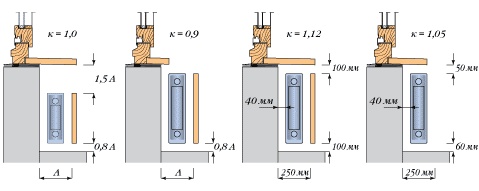
It is very important to make such calculations correctly. It depends on how efficient and economical the resulting heating system will be. All the information provided in the article is aimed to help the man in the street with these calculations.
